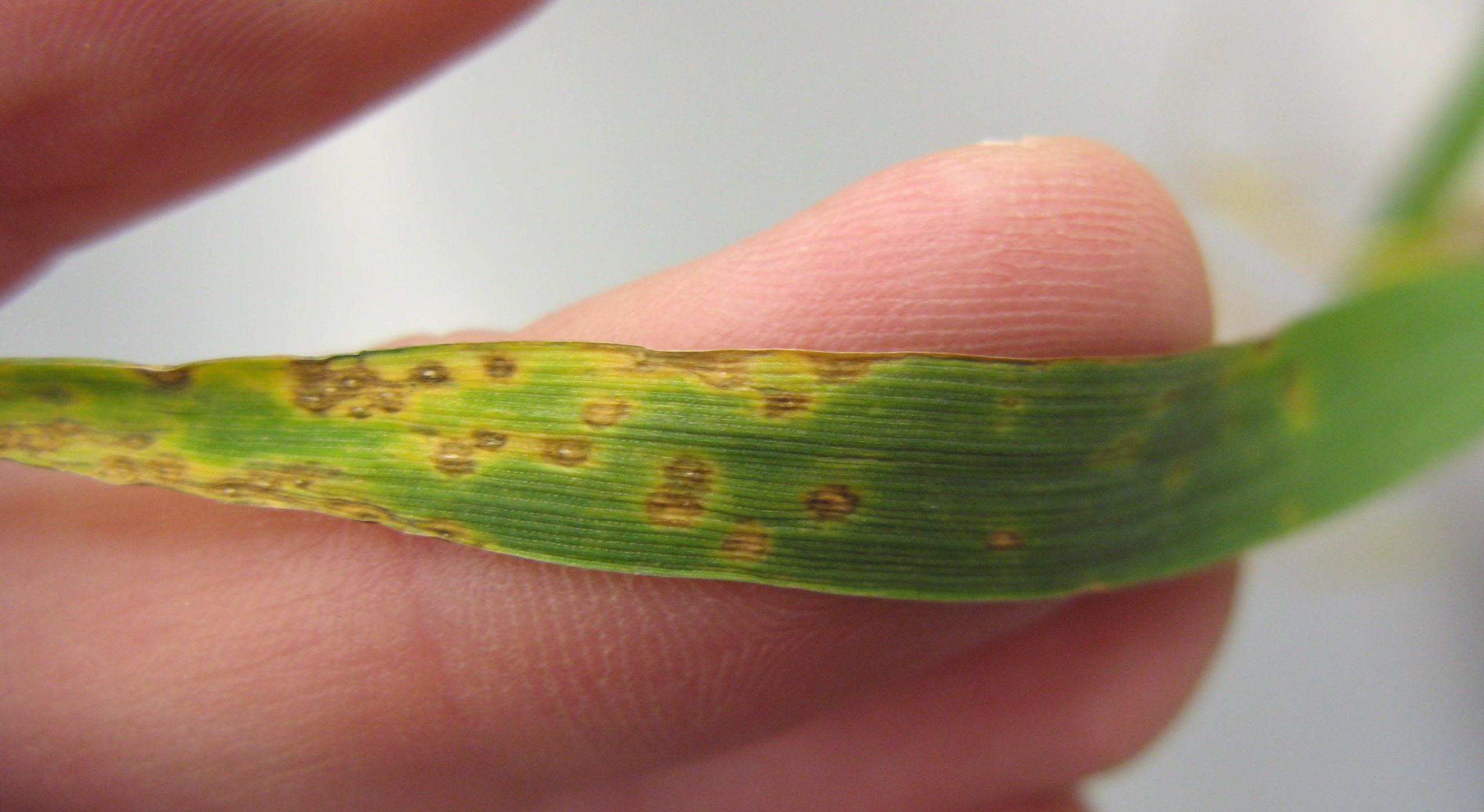
Blackpoint, Leaf Spotting and Smudge of Wheat
Leaf Spotting Complex of Wheat
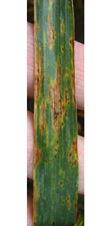
Leaf spotting diseases affect wheat grown on the Canadian Prairies and the Great Plains of the United States (Figure 1). They can be caused by one or a combination of leaf spotting pathogens. Pyrenophora tritici-repentis causes tan spot on leaves and can also infect wheat kernels causing red or pink smudge and black point. Severely infected kernels can result in significant down grading of seed quality. Although tan spot and red smudge are caused by the same fungus, severe leaf spotting does not necessarily result in high levels of red smudge. Conversely, high levels of red smudge may affect seed quality without the presence of severe leaf-spotting symptoms. Septoria/Stagonospora species cause leaf blotch on leaves and S. nodorum can also cause glume blotch. Cochliobolus sativus causes spot blotch on leaves, and can also infect other plant parts causing root and crown rots, head and seedling blights, node cankers and black point or kernel smudge. Leaf spotting diseases reduce the photosynthetic area of leaves resulting in reduced grain filling and lower yields; particularly when the top two leaves (penultimate and flag leaves) are severely infected. Yield losses caused by tan spot can be as high as 30 to 40 per cent, but generally range from three to 15 per cent.
Symptoms
Leaf spotting disease can infect growing wheat plants at any time during development.
Tan Spot (Pyrenophora tritici-repentis)

Initially, small, tan, brown flecks or spots appear on lower leaves (Figure 2). The spots enlarge into tan, irregular lens-shaped lesions about five to 13 mm long with a dark brown spot in the centre and a bright yellow zone surrounding the tan lesion. Lesion type and symptoms can vary from a tan blotch with a dark brown centre and no surrounding yellow zone to a tan blotch surrounded by a yellow zone without a dark brown centre. Tan spot lesions usually remain small on actively growing young leaves, however, when spots are abundant, the leaves turn yellow which gives the field an overall yellow cast.
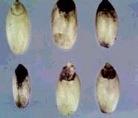
Red smudge on wheat kernels is favoured by wet weather during grain filling if large numbers of air-borne spores are present. Infected kernels appear red or pink and occasionally slightly smaller and wrinkled. The red stain is often noticed at the germ end and in the crease but can cover the entire wheat kernel resulting in significant downgrading (Figure 3). Durum wheat containing 0.27 per cent to one per cent red smudge kernels will cause a drop from grade #1 to #2 CWAD.
Conditions favourable for seed infection and red smudge development do not occur every year. Planting seed with large numbers of red smudge kernels can result in reduced stands and lower grain yield particularly in durum wheat. Seedling emergence is further reduced when red smudge seed is planted below three inches.
Septoria Leaf Blotch (Septoria tritici)
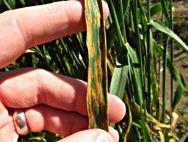
Initially, yellow flecks first appear on the lower leaves, especially on leaves in contact with the soil. Spots develop into yellow, greyish-white or brown blotches on all plant parts above ground. Leaves have yellow-bordered lesions that are restricted by the veins. Development of lesions is longitudinally with parallel sides and blunt ends. Elongated blotches range up to five by 15 mm and eventually coalesce.
Stagonospora nodorum blotch and Stagonospora leaf blotch (Stagonospora nodorum or S. avenae)
Leaf lesions caused by S. nodorum are usually light with dark margins and are less restricted than S. tritici lesions. Stagonospora nodorum may also cause blotches on the glumes and nodes as the plants mature. Glume infections often originate at the tips and spread downwards as purplish brown to grey lesions with dark pycnidia. Yellow flecks that appear on the leaves and enlarge into greyish-brown oval or lens-shaped blotches with a yellow border and inconspicuous pycnidia are more likely attributed to S. avenae.
Spot Blotch (Cochliobolus sativus)
Initially, spot blotch lesions are small (two to four mm) dark brown spots. Unlike the spots in barley, these spots do not coalesce to form blotches unless infections are very severe. Seedling blight and common root rot is prevalent under hot, arid conditions. Infected plants may be scattered throughout the field, appearing with poor emergence, brown lesions on lower plant parts, and seedling death. Black point and kernel smudge caused by a complex of pathogens including C. sativus represents brownish to black discolouration of kernels, favoured by rainfall or irrigation and warm weather during seed maturation.
As leaf spotting diseases develop, under environmental conditions favourable for disease, leaf spots coalesce and produce large areas of dead tissue. Severely diseased leaves eventually wilt and die prematurely.
Disease Cycle
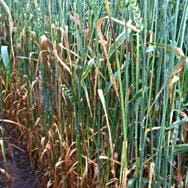
Growing conditions favourable for wheat production also favour leaf spot development. Leaf spotting fungi survive and reproduce on infected wheat straw or stubble and spread by different types of spores depending on the pathogen. Septoria tritici, S. nodorum and S. avenae are seed borne, and survive within infested residue over the winter. In the spring, asexual spores,conidia from the pycnidia and sexual spores, ascospores initiate disease infection. In the spring, the primary source of C. sativus inoculum is spores produced on infected residue, but spores may also persist in the soil for years. In the spring, large numbers of P. tritici-repentis ascospores produced in slightly raised black pinhead-size fruiting structures called pseudothecia are the primary source of inoculum. These distinctive fruiting structures are visible on weathered wheat stubble and straw on the soil surface and feel like rough sandpaper to the touch (Figure 6). Presence of these fruiting structures (Figure 7) indicates tan spot may be partially responsible for the leaf spot diseases in that field.
Inoculum is discharged from the crop residue to the lower leaves of tillering plants. At least six hours of leaf wetness either due to rain showers, fog or heavy dew is required for infection. Lesions develop within five to seven days if conditions are favourable after infection.
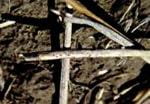
Mature lesions eventually produce asexual spores called conidia that spread by wind or rain splash from the lower leaves to the upper leaves and head. Disease development is favoured by periods of overcast, high humidity with fog or rain and warm temperatures (18 to 28 C). Leaves of seedlings and tillering wheat plants can become severely diseased during a warm wet spring. However, farmers may not notice leaf spots until flag leaf emergence or early heading.
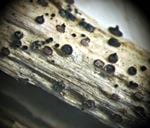
Tan spot can infect crested and intermediate wheatgrass, Russian and Altai ryegrass, bromegrass, and other grass hosts. Rye and barley can also be infected; however, the disease does not develop significantly enough to affect yields. The impact of alternative hosts as sources of inoculum on disease outbreaks in wheat grown in Saskatchewan has not been determined. The septoria/stagonospora leaf blotch complex occurs on wheat and other small grains, but there is some host specificity in special forms (forma specialis) of certain pathogens as well as with similar pathogen species. Stagonospora avenae f.sp. triticea affects wheat, triticale and barley, but other forms occur on rye and oat. Septoria triseti, the causal agent of leaf mottle of canaryseed, is incapable of infecting bread wheat and durum wheat, while S. tritici is unable to infect canary seed. Spot blotch (C. sativus) affects both barley and wheat. Oats are immune to the leaf spot infections discussed here.
Disease Management
Seed
Planting seed containing large numbers of infected kernels can result in reduced emergence, poor establishment and vigour of infected plants and should be avoided. Planting infected kernels does not necessarily affect the severity of leaf spot on the wheat seedlings.
Tillage
Conservation tillage practices retain soil moisture but can leave large quantities of leaf spot infested stubble and straw on the soil. Leaf spotting diseases caused by stubble-borne pathogens tend to be more severe under conservation than conventional tillage systems when environmental conditions favour disease development. Burying wheat residue through cultivation hastens decomposition and physically prevents air-borne spores from infecting leaves of young tillering wheat plants. Cultivation will not affect disease caused by spores blown in from other fields later on in the growing season. Although wheat stubble is a primary source of inoculum, the benefits of conservation tillage for preserving soil moisture far outweigh the risks of early disease development.
Crop Rotation
In most wheat growing areas, infested wheat straw and stubble from the previous year carry significant amounts of spore-bearing fruiting structures. However, in southwest Saskatchewan and possibly other regions, heaviest production of fruiting structures were found on two-year old infested wheat residue. Planting wheat into fields covered with wheat stubble or straw two years after the previous wheat crop could result in more disease on seedlings and tillering plants. Crop rotation with canola, mustard, flax, peas, beans, chickpea, lentil, potatoes and fallow for two or more years will significantly reduce the risk of early infection on young wheat plants.
Fungicides
The flag leaf is responsible for filling wheat kernels and a loss of photosynthetic area can reduce kernel weight and yield. Therefore, protecting the flag leaf with a foliar applied fungicide can reduce the yield loss due to leaf spot diseases. However, the economic benefit of a fungicide application will depend on the price of grain, the loss in yield caused by the disease if uncontrolled and the cost of the fungicide including application. Fungicides do not cure diseases and should be applied before disease develops on the flag leaf. Never apply a fungicide if the flag leaves are already severely diseased.
Consult the Guide to Crop Protection and Product Labels for more information on fungicides registered for leaf spot control in wheat.
Resistance
There is considerable variation in leaf spot resistance in current wheat varieties available to Saskatchewan farmers; ranging from very poor to fair. Durum wheat varieties tend to be more susceptible to tan spot than hard red spring wheat. In general, individual varieties will perform differently depending on the predominant pathogen and race in each environment. Better sources of resistance have been identified in breeding programs in Western Canada and more leaf spot resistant varieties will be available in the future. Consult the Varieties of Grain Crops publication for specific variety susceptibility to leaf spotting diseases.
For the latest information and for more updates on everything Kindersley ‘Like’ the Kindersley Social Facebook page below…








































